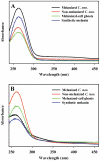Protection of melanized Cryptococcus neoformans from lethal dose gamma irradiation involves changes in melanin's chemical structure and paramagnetism
- PMID: 21966422
- PMCID: PMC3178601
- DOI: 10.1371/journal.pone.0025092
Protection of melanized Cryptococcus neoformans from lethal dose gamma irradiation involves changes in melanin's chemical structure and paramagnetism
Abstract
Certain fungi thrive in highly radioactive environments including the defunct Chernobyl nuclear reactor. Cryptococcus neoformans (C. neoformans), which uses L-3,4-dihydroxyphenylalanine (L-DOPA) to produce melanin, was used here to investigate how gamma radiation under aqueous aerobic conditions affects the properties of melanin, with the aim of gaining insight into its radioprotective role. Exposure of melanized fungal cell in aqueous suspensions to doses of γ-radiation capable of killing 50 to 80% of the cells did not lead to a detectable loss of melanin integrity according to EPR spectra of melanin radicals. Moreover, upon UV-visible (Xe-lamp) illumination of melanized cells, the increase in radical population was unchanged after γ-irradiation. Gamma-irradiation of frozen cell suspensions and storage of samples for several days at 77 K however, produced melanin modification noted by a reduced radical population and reduced photoresponse. More direct evidence for structural modification of melanin came from the detection of soluble products with absorbance maxima near 260 nm in supernatants collected after γ-irradiation of cells and cell-free melanin. These products, which include thiobarbituric acid (TBA)-reactive aldehydes, were also generated by Fenton reagent treatment of cells and cell-free melanin. In an assay of melanin integrity based on the metal (Bi(+3)) binding capacity of cells, no detectable loss in binding was detected after γ-irradiation. Our results show that melanin in C. neoformans cells is susceptible to some damage by hydroxyl radical formed in lethal radioactive aqueous environments and serves a protective role in melanized fungi that involves sacrificial breakdown.
Conflict of interest statement
Figures






Similar articles
-
The radioprotective properties of fungal melanin are a function of its chemical composition, stable radical presence and spatial arrangement.Pigment Cell Melanoma Res. 2008 Apr;21(2):192-9. doi: 10.1111/j.1755-148X.2007.00430.x. Pigment Cell Melanoma Res. 2008. PMID: 18426412
-
Morphological changes in melanized and non-melanized Cryptococcus neoformans cells post exposure to sparsely and densely ionizing radiation demonstrate protective effect of melanin.Fungal Biol. 2018 Jun;122(6):449-456. doi: 10.1016/j.funbio.2017.08.010. Epub 2017 Sep 6. Fungal Biol. 2018. PMID: 29801788
-
Ionizing radiation changes the electronic properties of melanin and enhances the growth of melanized fungi.PLoS One. 2007 May 23;2(5):e457. doi: 10.1371/journal.pone.0000457. PLoS One. 2007. PMID: 17520016 Free PMC article.
-
Synthesis and assembly of fungal melanin.Appl Microbiol Biotechnol. 2012 Feb;93(3):931-40. doi: 10.1007/s00253-011-3777-2. Epub 2011 Dec 16. Appl Microbiol Biotechnol. 2012. PMID: 22173481 Free PMC article. Review.
-
[Melanin and its role on the virulence of Cryptococcus neoformans].Mikrobiyol Bul. 2010 Jul;44(3):519-26. Mikrobiyol Bul. 2010. PMID: 21064003 Review. Turkish.
Cited by
-
A Naganishia in high places: functioning populations or dormant cells from the atmosphere?Mycology. 2017 Jul 12;8(3):153-163. doi: 10.1080/21501203.2017.1344154. eCollection 2017. Mycology. 2017. PMID: 30123637 Free PMC article.
-
Cell wall modifications during conidial maturation of the human pathogenic fungus Pseudallescheria boydii.PLoS One. 2014 Jun 20;9(6):e100290. doi: 10.1371/journal.pone.0100290. eCollection 2014. PLoS One. 2014. PMID: 24950099 Free PMC article.
-
Functions of fungal melanin beyond virulence.Fungal Biol Rev. 2017 Mar;31(2):99-112. doi: 10.1016/j.fbr.2016.12.003. Epub 2017 Jan 18. Fungal Biol Rev. 2017. PMID: 31649746 Free PMC article.
-
Inhibition of Melanization by Kojic Acid Promotes Cell Wall Disruption of the Human Pathogenic Fungus Fonsecaea sp.Pathogens. 2022 Aug 17;11(8):925. doi: 10.3390/pathogens11080925. Pathogens. 2022. PMID: 36015045 Free PMC article.
-
Natural compounds from freshwater mussels disrupt fungal virulence determinants and influence fluconazole susceptibility in the presence of macrophages in Cryptococcus neoformans.Microbiol Spectr. 2024 Mar 5;12(3):e0284123. doi: 10.1128/spectrum.02841-23. Epub 2024 Feb 8. Microbiol Spectr. 2024. PMID: 38329361 Free PMC article.
References
-
- Turick CE, Caccavo F, Jr, Tisa LS. Electron transfer from Shewanella algae BrY to hydrous ferric oxide is mediated by cell-associated melanin. FEMS Microbiol Lett. 2003;220:99–104. - PubMed
Publication types
MeSH terms
Substances
Grants and funding
LinkOut - more resources
Full Text Sources

